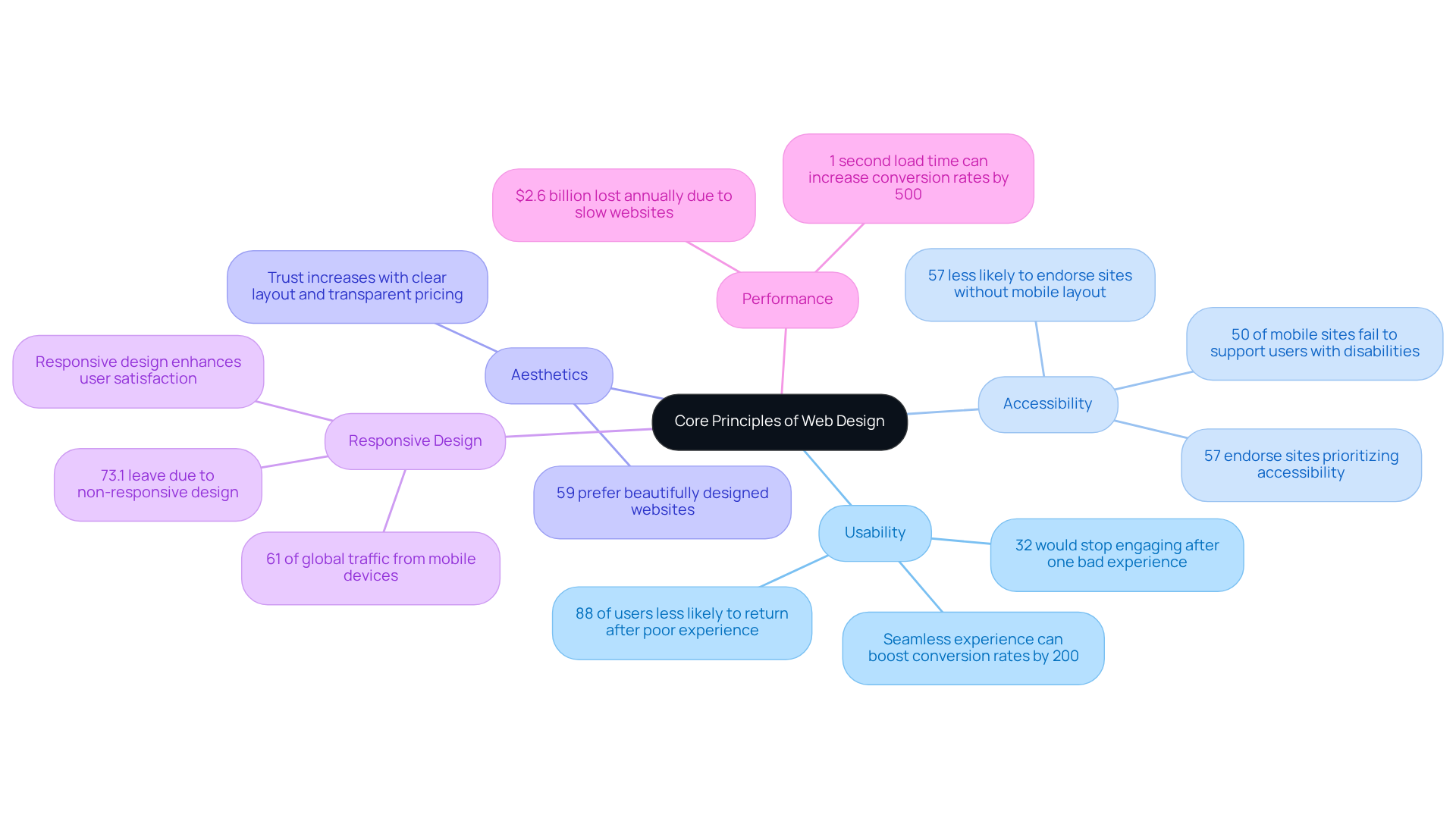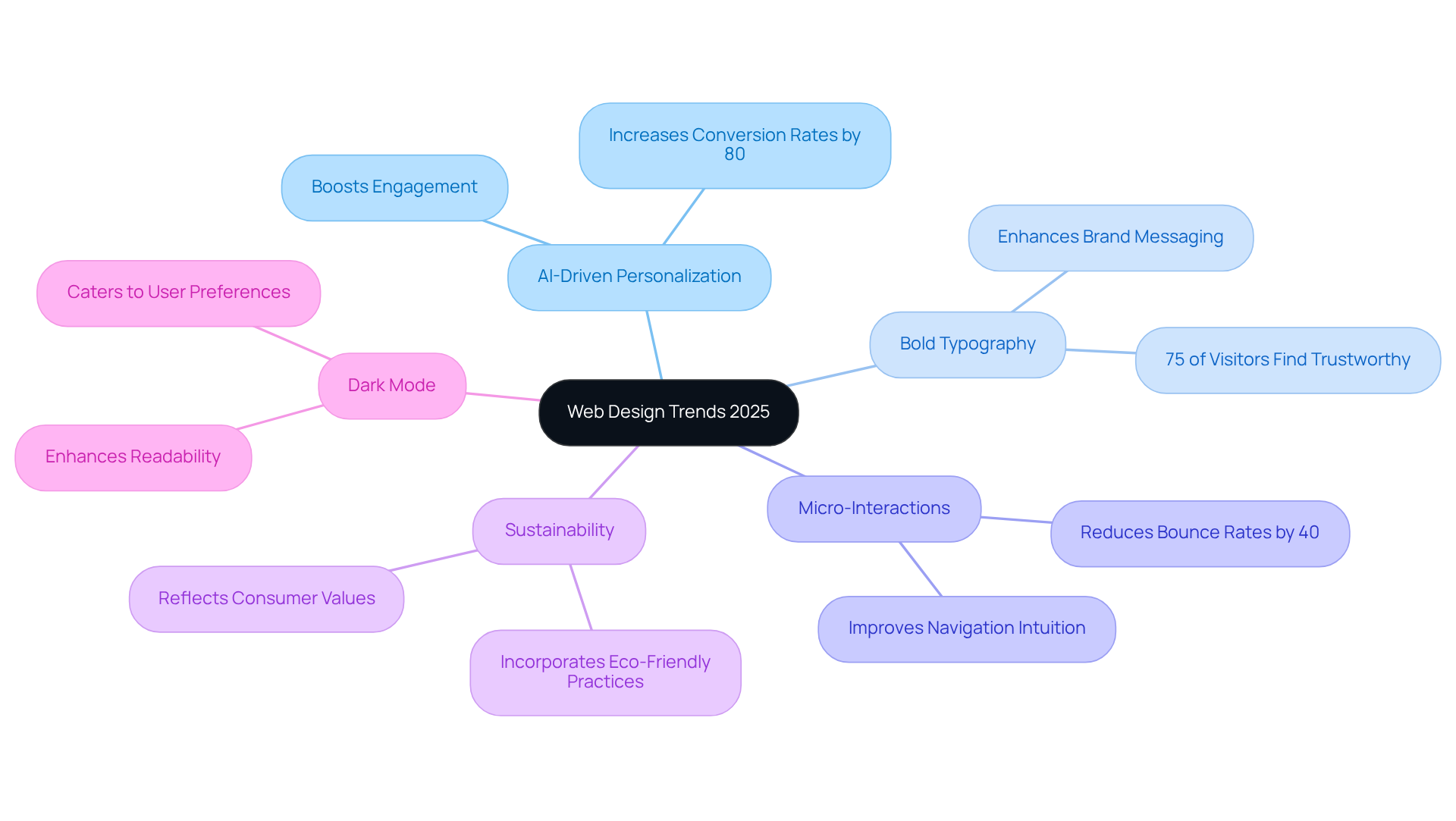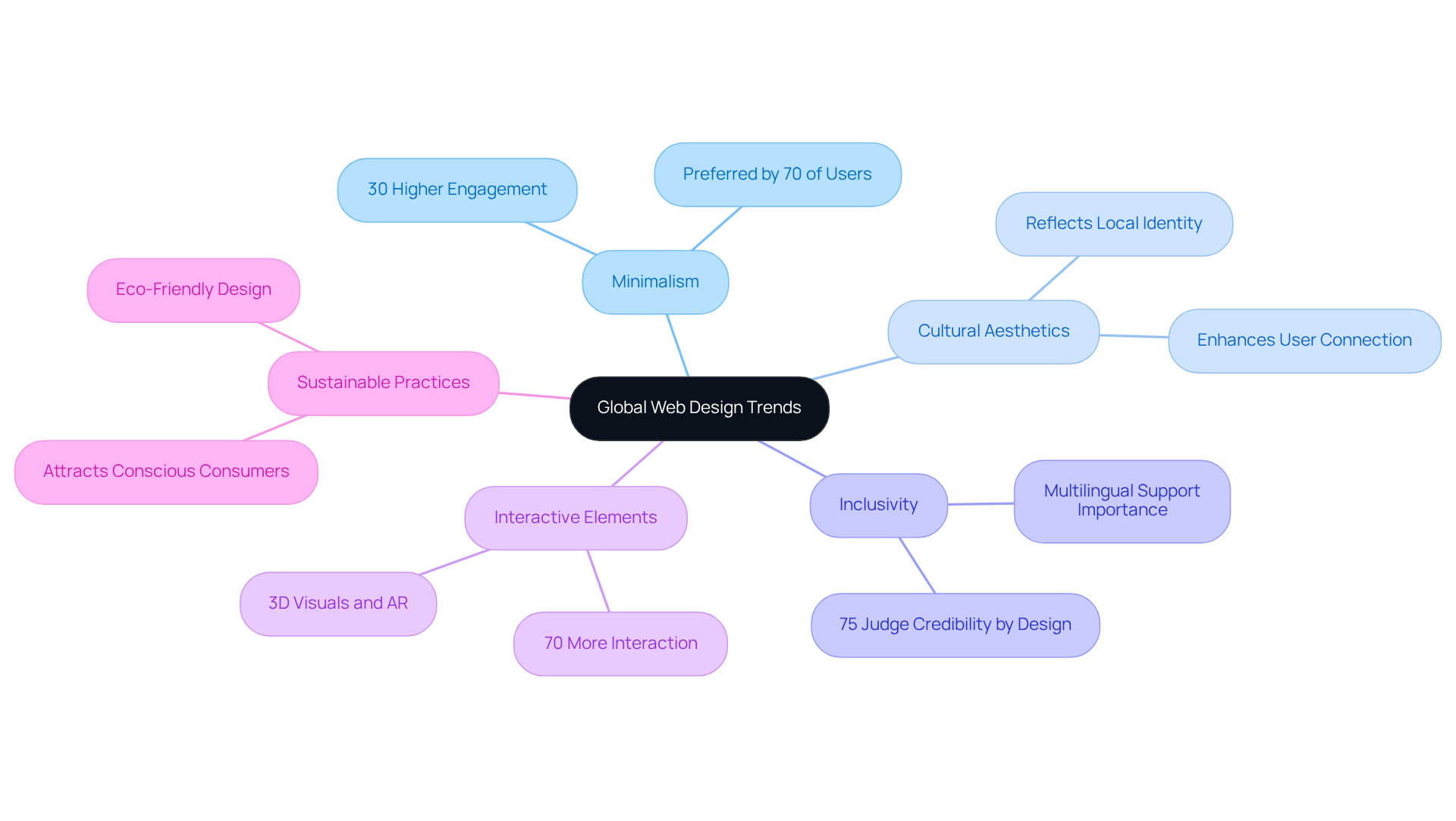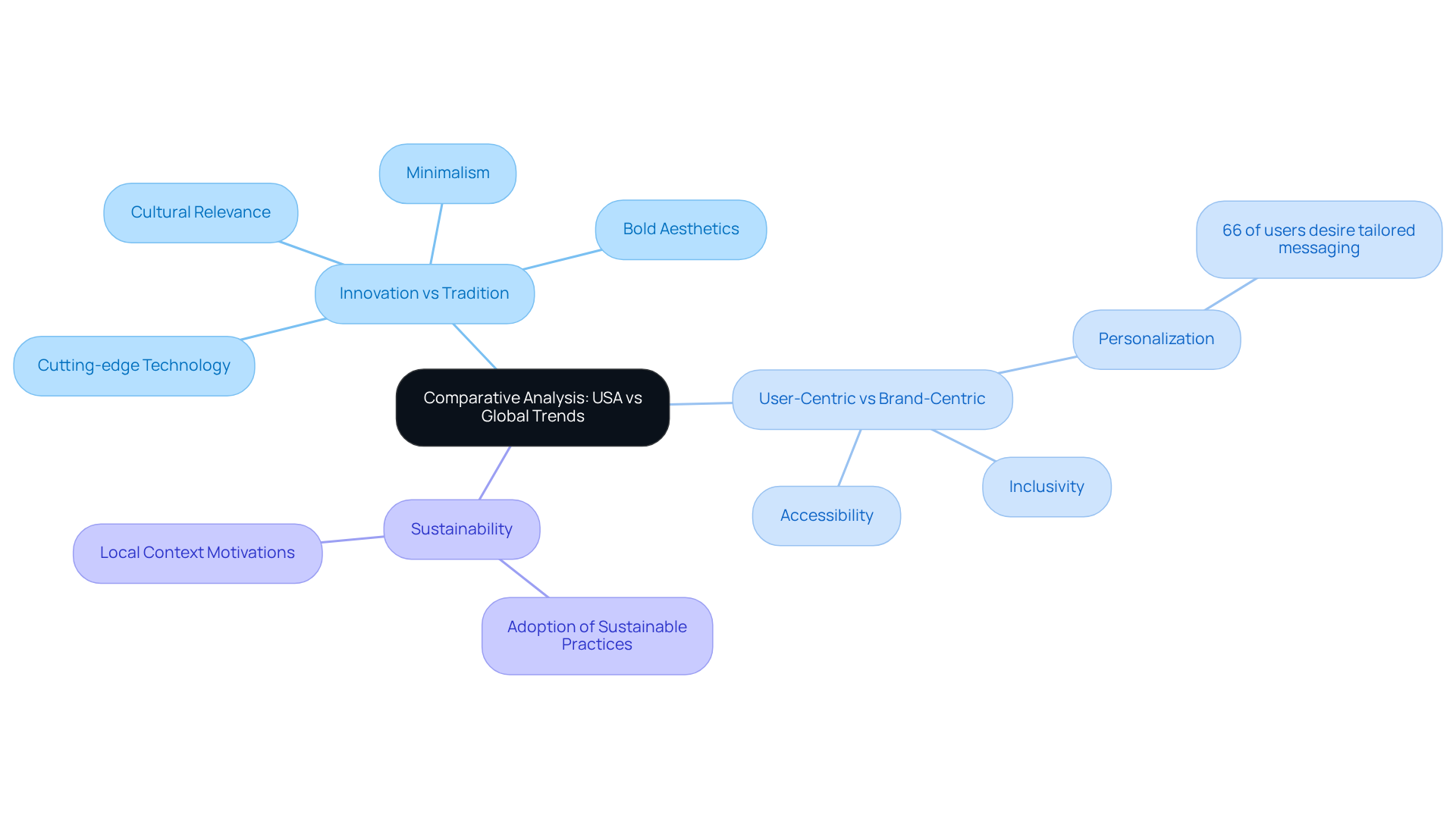Introduction
In today’s digital world, where first impressions can truly make or break a business, it’s vital to grasp the subtleties of web design. Many tech startup founders find themselves overwhelmed by the ever-evolving trends that shape an effective online presence. From usability and accessibility to aesthetics and performance, the landscape can feel daunting.
But here’s the thing: as new and innovative approaches emerge both in the USA and globally, it’s easy to feel lost in the crowd. How can you ensure your website not only resonates with users but also stands out in an increasingly competitive market? This is a common struggle, and it’s one that many founders face.
However, there’s hope. This article explores the dynamic relationship between American web design trends and global innovations, revealing opportunities for growth and engagement that you can seize. By understanding these trends and implementing them thoughtfully, you can create a website that not only attracts attention but also fosters connection with your audience. Let’s navigate this journey together, ensuring your startup thrives in the digital landscape.
Defining Web Design: Core Principles and Practices
Creating an effective and engaging website can feel overwhelming, especially when you consider the myriad of principles that come into play. Many founders struggle with this, and it’s understandable. After all, a website is often the first impression potential customers have of your business.
-
Usability is a significant concern. Imagine pouring your heart into a product, only to have users leave your site because they can’t find what they need. Studies show that 88% of users are less likely to return after a poor experience. This isn’t just a statistic; it’s a reality that can impact your business. A seamless experience can boost conversion rates by as much as 200%.
-
Then there’s accessibility. It’s crucial to design sites that everyone can use, including individuals with disabilities. Following guidelines like WCAG isn’t just about compliance; it’s about inclusivity. When you prioritize accessibility, you’re likely to earn the endorsement of 57% of individuals who value this commitment. And let’s not forget mobile users-57% of people are less inclined to endorse sites that don’t have a proper mobile layout. This highlights the importance of accessibility in our increasingly mobile world.
-
Aesthetics also play a vital role. We all know that first impressions matter. Research indicates that 59% of consumers prefer beautifully designed websites, which can lead to higher returns on investment. As Salesforce wisely points out, "Trust and credibility increase with clear layout, security badges, and transparent pricing."
-
Responsive design is another key element. With over 61% of global website traffic coming from mobile devices, ensuring your site works well on various devices is essential. It enhances user satisfaction and engagement, making your visitors feel valued.
-
Lastly, let’s talk about performance. Slow load times can be a dealbreaker. A site that loads in one second can have conversion rates five times higher than one that takes ten seconds. Retailers lose a staggering $2.6 billion annually due to slow websites. Fast load times not only enhance user satisfaction but also foster loyalty.
These principles serve as a foundation for assessing web aesthetics in web design USA and around the world. As the landscape of web creation evolves, it’s crucial to prioritize usability, accessibility, and aesthetics. By doing so, you’re not just building a website; you’re creating a welcoming space for your audience. At RNO1, we understand these challenges and are here to support you in navigating them, ensuring your success in 2025 and beyond.

Exploring USA Web Design Trends: Innovations and Standards
In 2025, navigating the web design USA landscape can feel overwhelming for many tech startup founders. With so many trends emerging, it’s easy to feel lost in the sea of options. But understanding these trends can significantly impact your brand’s online presence and user engagement.
-
AI-Driven Personalization is one of the most exciting innovations. Imagine a website that knows your visitors so well it can tailor content just for them. This isn’t just a dream; it’s a reality that can boost engagement and satisfaction. Personalized content can increase conversion rates by as much as 80%. At RNO1, we believe that these customized interactions should not only be functional but also visually appealing. We’ve seen firsthand how tailored content can lead to measurable increases in engagement, making your users feel valued and understood.
-
Then there’s Bold Typography. Large, striking fonts do more than just catch the eye; they communicate your brand’s identity. Research shows that 75% of visitors find websites with web design USA to be more trustworthy. At RNO1, we harness this trend to enhance brand narratives, ensuring that your message resonates deeply with your audience. Our recent projects have successfully utilized bold typography to strengthen brand messaging, creating a sense of trust and connection.
-
Micro-Interactions are another vital aspect. These subtle animations and feedback mechanisms guide users through their journey, making navigation feel intuitive. Did you know that clear navigation can reduce bounce rates by up to 40%? At RNO1, we seamlessly integrate these interactions into the user experience, enhancing usability and ensuring that every visitor feels at home on your site.
-
Sustainability is more than just a buzzword; it’s a movement. As consumers become more environmentally conscious, they seek brands that reflect their values. RNO1 is proud to lead this charge, incorporating eco-friendly practices into our projects. From energy-efficient hosting solutions to sustainable materials, we prioritize corporate responsibility, ensuring your brand stands out for all the right reasons.
-
Lastly, let’s talk about Dark Mode. This aesthetic choice not only enhances readability but also caters to users’ preferences for comfortable viewing experiences. As more people gravitate towards dark mode, it’s becoming a standard in web design. At RNO1, we embrace this trend, ensuring that your website is not just functional but also a pleasure to use.
These trends illustrate a beautiful blend of technology and user-focused design, positioning web design USA as a leader in innovation. At RNO1, we’re here to support you every step of the way, ensuring that your web presence not only meets but anticipates the needs of your audience. Together, we can create a digital experience that resonates, engages, and inspires.

Analyzing Global Web Design Trends: Influences and Innovations
In the ever-evolving world of web design, many tech startup founders face a common challenge: how to create a website that truly resonates with users while standing out in a crowded digital landscape. This can feel overwhelming, especially when trends shift so rapidly. But understanding global web design trends in 2025 can provide the inspiration needed to navigate this complex environment.
One significant trend is minimalism. Designers around the world are embracing clean, simple layouts that prioritize content over unnecessary embellishments. This shift not only enhances usability but also reflects a growing preference for clarity and efficiency. In fact, statistics show that minimalist websites can see a 30% rise in engagement. Imagine the relief of knowing that a straightforward design can lead to a more meaningful connection with your audience.
Another important aspect is the incorporation of cultural aesthetics. By weaving local cultural elements into designs, creators can reflect the identity and values of specific regions. This approach resonates deeply with local audiences, fostering a sense of connection and relevance. As one global creator noted, integrating cultural stories into website development can lead to more relatable experiences. This is a powerful reminder of how our backgrounds shape our interactions.
Inclusivity is also at the forefront of design trends. Websites that cater to diverse audiences through multilingual support and culturally relevant imagery are becoming increasingly vital. With 75% of individuals assessing a company's credibility based on its website aesthetics, it’s clear that representation matters. This trend not only builds trust but also creates a welcoming environment for all users.
Moreover, the rise of interactive elements is transforming user experiences. Features like 3D visuals and augmented reality invite users to engage more deeply with content. Websites that incorporate these interactive features can see up to 70% more interaction. This is an exciting opportunity for startups to create memorable experiences that captivate their audience.
Lastly, sustainable practices are gaining traction. While sustainability is a concern in the USA, global creators often focus on local environmental issues, integrating eco-friendly practices into their processes. This commitment not only addresses urgent global challenges but also attracts environmentally conscious consumers. It’s heartening to see a movement that aligns business with a greater purpose.
These trends illustrate how global perspectives can enrich the web design USA landscape, offering innovative methods that can inspire tech startup founders in the United States. By embracing these insights, you can create a website that not only meets the needs of your audience but also reflects your values and vision.

Comparative Analysis: USA vs Global Trends
When we examine web design trends in the USA in relation to those worldwide, it becomes evident that both differences and similarities emerge, which can be quite overwhelming for many designers.
-
Innovation vs Tradition: In web design USA, trends often lean towards cutting-edge technology and bold aesthetics. This can feel exciting but also daunting. Meanwhile, global trends tend to embrace minimalism and cultural relevance, which can sometimes feel more grounded and relatable.
-
User-Centric vs Brand-Centric: Many web design USA creations emphasize brand identity and user engagement through personalization. In fact, 66% of users express a desire for tailored messaging, according to McKinsey & Company. This focus on individual experience can create a sense of connection, but it also raises the stakes for designers. On the flip side, global designs often prioritize inclusivity and accessibility, reminding us that every user deserves a voice.
-
Sustainability: Both regions are increasingly adopting sustainable practices, which is heartening to see. However, the motivations and implementations can differ based on local contexts, making it essential for designers to understand their audience's values.
Cultural influences on web design in the USA are heavily shaped by technological advancements and consumer behavior. In contrast, global developments reflect a rich tapestry of cultural narratives and values. For instance, it’s fascinating to note that 89% of businesses are now utilizing video as a marketing tool in 2025, showcasing a shift towards dynamic content that resonates across cultures.
This comparative analysis highlights the ever-evolving nature of web design USA. It encourages designers to draw inspiration from both USA and global trends, fostering a sense of community and collaboration. By embracing these diverse influences, we can create innovative and effective digital experiences that truly resonate with users.

Conclusion
Navigating the ever-changing world of web design trends can feel overwhelming for tech startup founders. With so many innovations emerging both in the USA and globally, it’s easy to feel lost in the shuffle. This challenge can lead to frustration, especially when trying to create an online experience that truly resonates with users.
However, understanding the nuances between local and global trends can be a game-changer. In the USA, there’s a strong focus on user-centric design, often characterized by bold aesthetics and personalized experiences. Meanwhile, global trends tend to embrace minimalism and cultural relevance, fostering inclusivity and community engagement. Both approaches offer valuable insights that can inspire your design process, helping you create a website that not only attracts users but also keeps them coming back.
As the web design landscape continues to evolve, it’s crucial to remain adaptable and informed. By prioritizing user needs and embracing innovative practices, you can craft a website that reflects your brand’s values and stands out in a crowded digital marketplace. Engaging with both local and global trends enriches your design journey and positions your brand for success in an interconnected world.
Remember, you’re not alone in this journey. Many founders have faced similar challenges and found ways to thrive by integrating these insights into their designs. By sharing experiences and learning from one another, we can create a supportive community that empowers us all to succeed. Let’s embrace the beauty of diverse influences and work together to create impactful online experiences.
Frequently Asked Questions
Why is usability important in web design?
Usability is crucial because a poor user experience can lead to 88% of users being less likely to return to a website. A seamless experience can significantly boost conversion rates by as much as 200%.
What role does accessibility play in web design?
Accessibility ensures that websites can be used by everyone, including individuals with disabilities. Following guidelines like WCAG is important for inclusivity and can enhance brand endorsement, as 57% of individuals value this commitment.
How does mobile design impact user engagement?
Mobile design is essential since 57% of users are less likely to endorse sites that lack a proper mobile layout. With a significant portion of web traffic coming from mobile devices, responsive design enhances user satisfaction and engagement.
What is the significance of aesthetics in web design?
Aesthetics matter because 59% of consumers prefer beautifully designed websites, which can lead to higher returns on investment. A clear layout, security badges, and transparent pricing also help increase trust and credibility.
How does website performance affect user retention?
Website performance is critical, as slow load times can deter users. A site that loads in one second can achieve conversion rates five times higher than one that takes ten seconds. Retailers lose approximately $2.6 billion annually due to slow websites.
What are the core principles of effective web design?
The core principles of effective web design include usability, accessibility, aesthetics, responsive design, and performance. Prioritizing these elements helps create a welcoming and engaging space for users.




